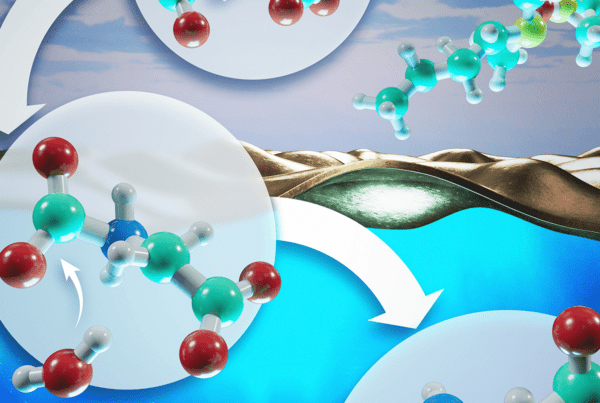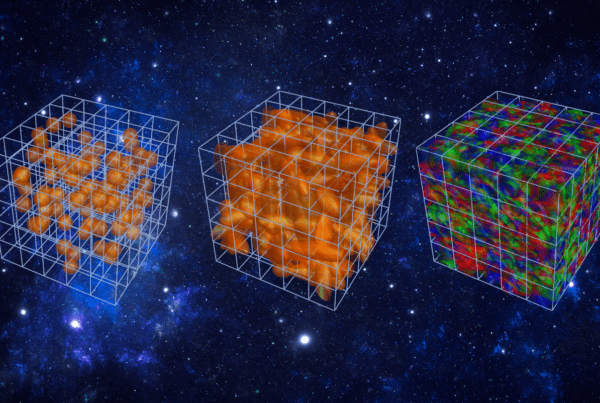It’s no surprise that Rudolph Diesel became a millionaire only 6 short years after he patented the first diesel engine in 1892. When used in cars and trucks, diesel engines can deliver better fuel economy than gasoline engines and can last hundreds of thousands of miles longer. The efficiency of present-day diesel engines warrants their use in construction, transportation, and industry.
Although diesel engines may have more longevity, they also emit pollutants such as nitrogen oxides, carbon monoxide, and particulate matter (soot). In hopes of addressing such problems, scientists study diesel engines and their combustion processes to develop predictive computer models for transportation systems. As these models improve, they can be used to build better diesel engines that may reduce the production of harmful emissions.
A team led by Joseph Oefelein, a distinguished technical staff member and combustion researcher at Sandia National Laboratories, is currently studying fuel systems in diesel engines at the US Department of Energy’s (DOE’s) Oak Ridge National Laboratory (ORNL) to develop new predictive models for transportation systems.
“Because we don’t have predictive models, combustion processes are not as efficient or as clean as they could be,” Oefelein said. “Development of advanced models will provide new optimization strategies that simultaneously maximize fuel economy while minimizing or eliminating harmful emissions such as soot.”
In particular, Oefelein’s team studies the complex processes that lead to autoignition, the spontaneous ignition of a fuel–air mixture. Each variable—air and fuel mixing, temperature, pressure, and jet spray pattern—is directly linked to the others and cannot easily be isolated. Consequently, studying these processes requires computationally intensive multiscale, multiphysics modeling.
“Our goal is to improve the predictive capability of the tools in general,” Oefelein said. “For example, if we could simulate fuel and air mixing to the point right before autoignition, we could examine and ultimately control the processes that lead to ignition and combustion.”
In 2015 the researchers simulated fuel injection processes on Titan, the Oak Ridge Leadership Computing Facility’s (OLCF’s) 27-petaflop supercomputer, and corroborated the results with experimental data. The OLCF is a DOE Office of Science User Facility located at ORNL. The team accessed Titan through an Advanced Scientific Computing Research Leadership Computing Challenge award.
Simulating Coupled Systems
In a diesel engine, air is compressed in a combustion chamber, creating heat. Fuel is then injected into the chamber, where it mixes with air until the mixture spontaneously ignites (autoignites) to power the engine.
Whereas previous experiments had already demonstrated the point at which fuel autoignites, Oefelein’s goal was to match the team’s simulations with experiments and study the processes that lead to ignition and combustion. The team simulated a research fuel injector mounted at the head of a high-pressure combustion vessel. To represent the geometry of these components, the team mapped out the combustion process using grids of between 500 million and 1 billion cells, each with spacing of approximately 2 cubic micrometers.
The team ran a progressive sequence of 24 simulations aimed at first comparing the results with available experimental measurements. They were ultimately able to extract information not available from experiments alone to gain further scientific insights. In the simulations they inject the same fuel at the same conditions that exist in the experiment to allow for experimental validation and collaborative comparison of results between research projects. Their models account for a range of scales from 10 centimeters to 1 micrometer in space on nanosecond intervals in time.
Using a mathematical model for turbulence called large eddy simulation (LES) and RAPTOR, a computational fluid dynamics code developed by Oefelein, the team mapped out dynamic and transient combustion processes in space and time, looking at the interactions between key physical processes and chemical reactions. Results from these simulations provided scientific insights into which conditions in an internal combustion engine are more favorable for autoignition. At high-pressure conditions under which fuel behaves like a supercritical fluid—a substance that is not distinctly a liquid or a gas—the mixing of fuel and air is enhanced. When efficient mixing has taken place, autoignition occurs in a much more uniform manner, which ultimately leads to more efficient combustion with minimal emissions.
“One of the things that happens is that pockets of fuel in the combustion chamber of an engine get trapped and combust, increasing the generation of soot and other emissions,” Oefelein said. “Developing efficient fuel injection and fuel–air mixing strategies allows the fuel to burn in a closer to optimal manner in the combustion chamber, reducing these emissions.”
The team used LES for its simulations because it provides more localized information about specific points in the flow than direct numerical simulations provide. LES resolves processes at multiple scales and allows for a simulation at conditions identical to those of the experiment. Accurately simulating the details of the processes leading to combustion is essential, Oefelein said, because researchers will be using these simulations to help guide the development of predictive engineering models used by industry to design engines.
“When we do these simulations, we must look at the coupled system of processes,” Oefelein said. “For example, even if we have a perfect model for the chemical kinetics mechanism, if I can’t accurately model the physics behind the multiscale mixing process of fuel and oxidizer, it doesn’t matter how good the chemical model is. We won’t get the right results.”
The team’s simulations each required approximately 4,000 of Titan’s GPUs—20 percent of the machine’s total GPUs. Using the computational power of Titan, the team was able to accurately model the full injection pulse up to and beyond autoignition to study the cascade of physical processes that ultimately leads to combustion.
Next-Generation Computers, Next-Generation Engines
This research offers a predictive model for fuel injection processes in diesel engines and could aid in the development of new strategies for injection processes in internal combustion engines in general.
Because Titan enables calculations over a large range of scales, the team at Sandia can simulate geometry and physics processes that would have been far too complex without a world-class machine, Oefelein said. He added that future computer architectures, such as the OLCF’s next-generation supercomputer, Summit, will continue to transform his team’s ability to develop and apply even more accurate models of combustion and fuel injection processes. The team’s RAPTOR code is one of the 13 Center for Accelerated Application Readiness codes currently being prepared to run on Summit.
“Computer power is getting cheaper, and at the same time the speed at which we can get solutions and high resolutions is going to increase dramatically,” Oefelein said. “That alone will open up many opportunities in research and development of engines through the use of entirely new classes of models that, prior to now, were still too expensive to even try.”
Oefelein’s collaborators include Guilhem Lacaze, a researcher at Sandia; Antony Misdariis, a researcher at the Centre Europeen de Recherche et de Formation Avancee en Calcul Scientifique in France; Anthony Ruiz, a research and development engineer at Laboratoires Industriels Pichot in France; and Ramanan Sankaran, a computational research scientist at the OLCF and joint faculty member at the University of Tennessee, Knoxville.
Related Publication:
Guilhem Lacaze, Antony Misdariis, Anthony Ruiz, and Joseph C. Oefelein, “Analysis of High-Pressure Diesel Fuel Injection Processes Using LES with Real-Fluid Thermodynamics and Transport.” Proceedings of the Combustion Institute 35, no. 2 (2015), doi: 10.1016/j.proci.2014.06.072.
Oak Ridge National Laboratory is supported by the US Department of Energy’s Office of Science. The single largest supporter of basic research in the physical sciences in the United States, the Office of Science is working to address some of the most pressing challenges of our time. For more information, please visit science.energy.gov.






